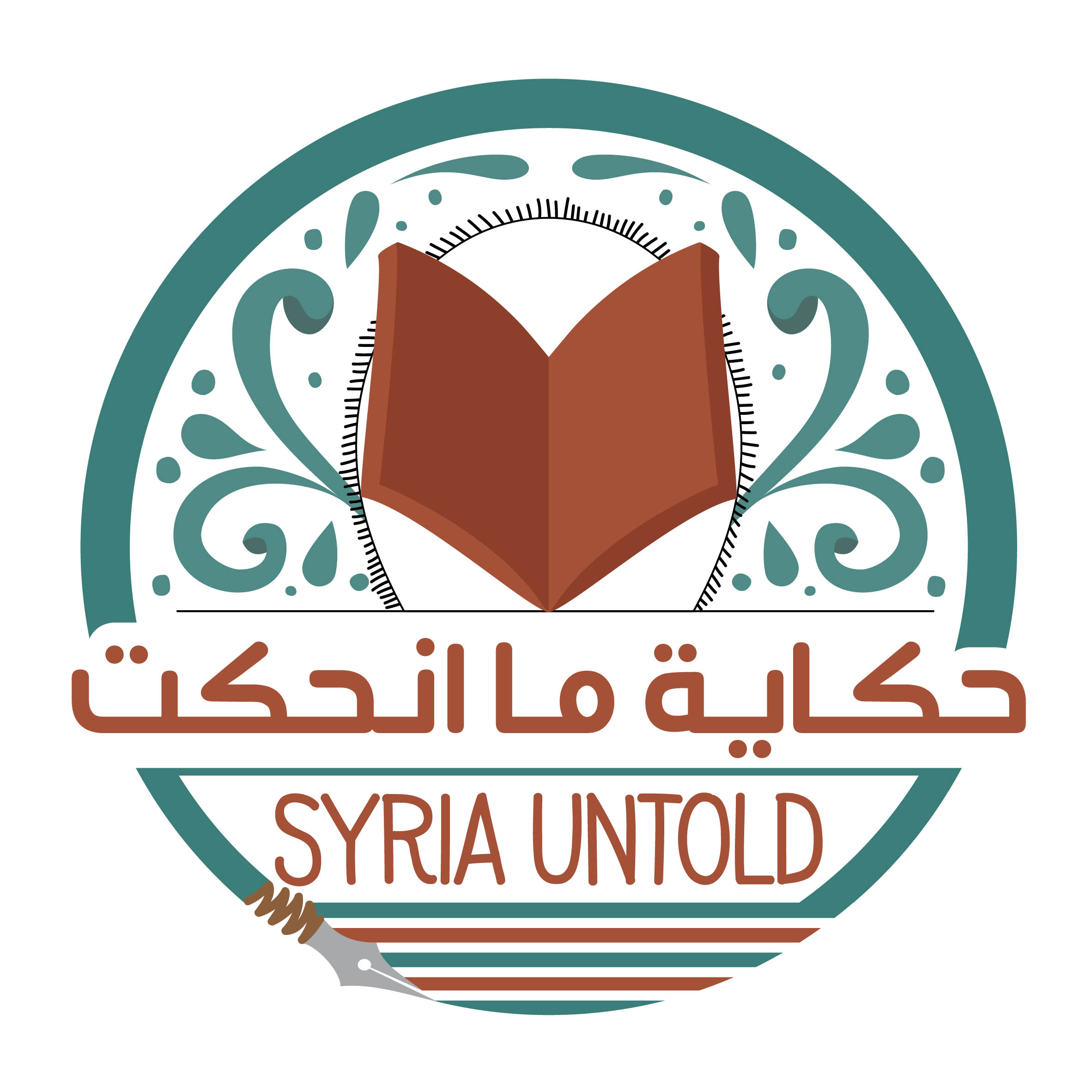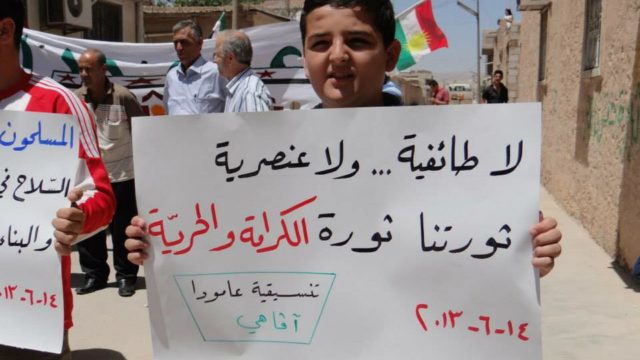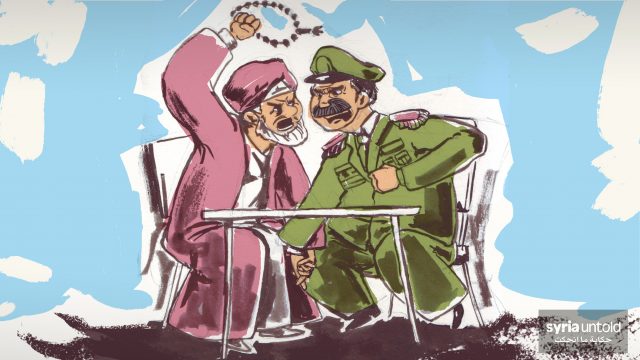Before the outbreak of the uprisings in the Arab world, the issue of the relationship between religion, state, secularism and modernity dominated discussion and debate— especially given the fact that at the same time any analysis of the authoritarian security structures of the ruling regimes was prohibited, at least in public.
Secularism is not a fully fledged project even in most Western democracies, which have often sought to restrict the issue of religion to the private sphere. This has been evident recently with the rise of the far right in several Western countries that claim to be implementing secularism, which demonstrates that the public sphere in most countries around the world is still imbued with religion, its manifestations and its symbols (albeit to varying degrees).
In the Arab world, and Syria in particular, the issue of the separation between religion and state has created severe polarization. In Syria, this polarization has led to the publication of a very many books on the topic, heated debates concerning a 2009 draft law to amend the country's civil status legislation, as well as proposals to legitimize civil marriage and tighten penalties for so-called “honor killings.”
After the Syrian uprising erupted in 2011 and transformed into a bloody conflict that has since torn apart the country’s social fabric, the state lost many of its economic resources and became politically dependent on other regional countries and superpowers. Meanwhile, the Syrian regime claims to support secularism while killing, arresting and imprisoning people in its name. Most of the existing opposition movements became dependent on foreign agendas that are far removed from the Syrian national space. This trend particularly affected armed groups recruited to serve neighboring countries and agendas more concerned with the regional balance of power than Syria’s national interest. This led to the propagation of sectarian rhetoric, supported by forces linked to other countries in the region that use sectarian slogans.
Given this military context, how can we understand the role of secularism? Can it be implemented without being turned into a repressive tool and an authoritarian mask, as is the case under most Arab totalitarian regimes—including the Syrian regime, which used secularism merely as an extension of the rhetoric of the “war on terror?”
Related articles
18 August 2018
Syrian secularists, and moreover the concept of secularism, are under attack online and on the ground. Joseph Daher takes a critical look at recent efforts to discredit the contribution of...
After years of war, new realities have emerged on the ground and various possibilities presented themselves. Debates on the issue of the relationship between the (future) state and religion have re-emerged, especially with the rise of jihadist and secular movements, and the divisions and hatred left by external interventions in the Syrian context. These factors have served to only deepen the divides between Syrians.
Despite this bitter reality, many Syrians are still looking for solutions—even theoretical ones—to extricate themselves from the catastrophe left behind by the utter failure of the civil movement, the suppression of the uprising and the disaster that followed the conflict itself.
Given this tragic situation, Syria Untold, Salon Syria and Jadaliyya together invite you to consider some of the following questions, before offering your opinions on how best to enrich the debate on secularism:
1. Given the history of secularism and its problems and terms of reference, and especially its emergence, is it possible in the Syrian context to come up with a fruitful secular formula or discourse that is characterized by religious, ethnic and cultural pluralism?
2. Some people think that the secular discourse that was prevalent before the uprising focused on the concept of secularism in the face of religion. But what are the questions that need to be asked and addressed in terms of the relationship between the state and Islam, and the relationship between Islam and other religions? After all that has happened in Syria in the name of Islam and religion, can religious discourse be secularized? What about the clergy and their relationship with secularism, did they contribute to the distortion of the concept of secularism? And given what has happened in recent years in the name of religion, can that experience help expose how politics disingenuously uses the name of religion?
3. How can citizenship—which is based on equal rights under the protection of the law regardless of gender, race, religion, or sect—pose an alternative to unilateral religious and ideological arguments? Is it necessary for citizenship to become an alternative, and why? And are there alternatives to secularism if it is deemed unnecessary, on the Syrian and Arab level? What are these alternatives?
4. What needs to be done to pave the way for a secular pluralistic system in Syria, in which women enjoy their full human rights without being reduced merely to their gender?
5. Which actors can guarantee implementation of secularism, and how can they be propped up? With the increased danger of institutionalized sectarianism, as well as the changes that accompanied the armed conflict, can secularism be a starting point for a future solution in Syria that guides the country away from the risks of the current status quo?
6. How can Syrian intellectuals help pave the way in disseminating a “secular culture” that can serve as the basis for a new secular system? How can we bridge the gap between Syria and the diaspora so that, for example, cultural production in countries of asylum is not isolated from the changes and challenges facing Syrians actually inside the country?
7. In many cases, a paradox has emerged whereby secular intellectuals advocate for secularism while using a discourse of exclusion that denies the right to faith and religious commitment. How can we avoid falling into the trap of tyranny and the exploitation of political forces that dominate the secular discourse? How can we advocate for a secular project in a manner that respects the relationship with faith and religion? And how does one foster co-existence between them?
Related articles
21 June 2017
Throughout the 20th century, the Arab world has always found itself operating either within an Islamist or nationalist framework. Despite political conflict between the two - sometimes even bloody -...
8. Until today, there is a prevailing narrative in the context of the Syrian uprising and conflict claiming that “some secularists” have embraced the Syrian regime because it is the “lesser evil” when compared with political Islam, and because they want to preserve what is left of state institutions to stop political Islam coming to power. To what extent does this discourse form either an instrument for tyranny or an instrument for the truth, as people on different sides of the argument claim? Has this discourse contributed to the “distortion” of secularism? And why?
9. What about the secular discourses from within religious and ethnic minorities in Syria? It’s often claimed that most Syrian minorities presumably support secularism, although the reality could be more complicated than that. What is the reason behind the spread of these claims? Are they based on facts, or are they part of the war of rhetoric among Syrians?
In the coming weeks, Syria Untold will publish a selection of articles from the new In Depth series on Secularism. The full series in Arabic can also be found here.






